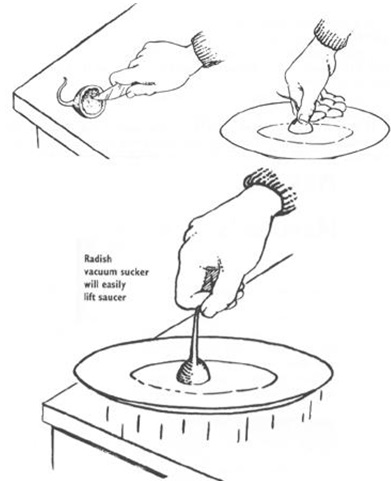Chapter: SCIENCE EXPERIMENTS & AMUSEMENTS FOR CHILDREN BY CHARLES VIVIAN. Simple Technical Steped Practical Projects for school and college students.
A Radish Vacuum

A Radish Vacuum
You will need: A knife, radish, and saucer.
'Nature abhors a vacuum'
and the outer air will always try to enter an area of lower air pressure. This
physical law has been put to use many times in various pieces of machinery and
equipment.
Possibly the vacuum cleaner
is the best known of these machines. Vacuum cleaners may vary in size, shape
and performance from maker to maker, but their basic principle is always the
same: a vacuum-or at least an area of low pressure-is created by some means
(usually electrical). The outer air is then allowed entry in such a manner that
it will carry with it any loose dirt, fluff, etc., in its path.
When we press a little
rubber suction device to the tiled wall of our bathroom, it is retained in
position by air pressure and not by some form of invisible glue.
You can make your own
simple form of vacuum sucker from an ordinary radish. Take a large, firm radish
and cut it in half with a single stroke of a sharp knife. With the point of the
knife scoop out some of the flesh of the radish to form a hollow in that half
of the radish which bears the long root.
Now press the half of radish firmly into the
center of a clean saucer.
Lift the radish by its root
and you will find that the radish adheres so firmly to the saucer that it
raises the plate from the table.
Air pressure is at work, of course. In cutting the radish with a single stroke of the knife you left a clean, flat surface. In scooping out a hollow in the middle of the radish you provided an air space. This air was completely expelled from the hollow when you pressed the radish half firmly against the saucer. The outer air tried to enter the vacuum created in the center of the radish, but the cut surface of the radish had joined in an airtight bond with the saucer. (This bond was further strengthened by juice squeezed from the radish when you exerted pressure to expel the air.) Air was unable to gain entrance and was left pressing down upon the outer surface of the radish, thus 'gluing' it to the saucer.
Related Topics